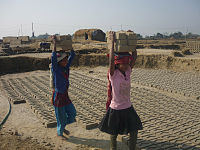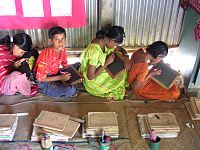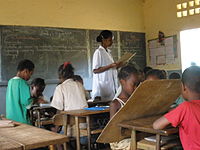|
Vikidia currently has 4,625 articles. Improve it! |
|
Join Vikidia: create your account now and improve it! |
Convention on the Rights of the Child
| This article was translated by Duolingo. There is an ongoing discussion about possible copyright issues. |
The Convention on the Rights of the Child is an international treaty whose objective is to establish and ensure the children's rights.
It was adopted the 20th of November, 1989 by the United Nations General Assembly. This assembly brings together the representatives of each member states of the United Nations. The Convention was then signed and ratified by most of the countries in the world. They promise thus one to every other to follow this text.
It follows the Declaration of the Rights of the Child, (which only was a United Nations resolution) which was adopted 30 years sooner and containing 10 articles called "principles".
Text

The text of the Convention on the Rights of the child can be found notably:
- The full text on the pages of the Committee on the Rights of the Child:
- a simplified text for children to read at droitsenfant.org
- the complete text, followed by a summary.
History
The idea of a statement on the rights of the child which has the value of an international treaty had been present for several years but it was the Polish government who took the initiative of this work and proposed to the UN in 1978 the first version of the convention. Poland was the country of origin of Janusz Korczak (died in 1942), who had think over, put into practice and written about the rights of the child. The representatives from Poland who proposed the project quoted Korczak and were inspired by his work.
The year 1979 was declared the "International Year of the Child" by the UN that accepted and supported the project. Delegates of the voluntary countries formed a working group to prepare the agreement, the project is also followed by several non-governmental organizations (NGOs) and institutions under the UN such as UNICEF and the Commission on Human Rights. Starting on 1979 until the convention's adoption, the work group, whose expenses are paid by the ONU, had an office for secretarial work at Geneva in Switzerland and it met twice a year, gathering the delegates of about 40 countries in the world. It was necessary that the text was adapted and acceptable by very different countries, at the same time being useful and effective
This work lasted 10 years. After the text has been modified and completed during this period, it was adopted November 20, 1989, exactly 30 years after the Declaration of the Rights of the Child. The convention entered into force (became valid) on the 2nd September 1990, one month after 20 countries had already ratified it. It was signed and ratified quickly compared to the other conventions of the UN, and by a vast majority of the countries. Today all the countries of the world except three have signed and ratified it, sometimes with reservations on a particular article. Only the United States, Somalia and the South Sudan have not ratified it. The United States often delays signing treaties that they thinks possibly restrictive, but the intention to ratify the convention is still ongoing. Somalia is in a difficult political situation and South Sudan is a country which only obtained its independence in 2011.
Contents
The Convention concerning the Rights of Children contains of a "preamble" and 54 articles in three parts. The first 41 talk about the rights themselves, the 2nd part talks about their enactment and the necessary resources to check it while the 3rd part arranges its legal enactment: that is to say when the convention enters into force once signed and ratified by the countries (the word convention stands for agreement or treaty) and how it can be amended or rounded off.
The definition of child for the enforcement of the convention is stipulated in the first article: it is about every human beings under 18, unless the majority is attained earlier under the laws in effect in one country. Nevertheless, an infant and an older teenager being so different, several sections stipulate that they are applied on the basis of the age or maturity of the child.
The articles of the convention establish different types of rights:
Identity and family
Several articles focus on identity and family.
These are the right to life, to a name and a nationality, the respect for the identity of the child. The right of non-separation between the child and parents is specified as follows: "States Parties shall ensure that a child shall not be separated from his or her parents against their will, except when competent authorities subject to judicial review determine, in accordance with applicable law and procedures, that such separation is necessary for the best interests of the child. Such determination may be necessary in a particular case such as one involving abuse or neglect of the child by the parent, or one where the parents are living separately and that a decision must be made as to the child place of residence." Afterwards the article states the right of the child separated from one or both parents to maintain direct contact with them or see them regularly (article 9).
Article 18 speaks of the obligation to raise the child. It says that the two parents are responsible of it, to assure his development. It is written that "the best interests of the child will be their basic concern" in it.
Article 5 speaks of the rights and duties of the parents to guide and direct their child. This may be the role of the extended family or of the community depending on the customs and each situation. Article 14, regarding freedom of thought, conscience and religion, declares that children have these rights, and further adds that parents have the right and duty to guide the child in the exercise of these rights, in a manner consistent with his/her age and capacities. Articles 30 states that children of minorities who have their own religion, culture or language may not be deprived of it.
Parents or the extended family have thus the right to transmit their identity, religion and culture to the child, while considering his liberty, in relation to his age. This makes that a state can not take children out of their families, communities or of the influence they have on this children, even if the representatives of this state declare that they aim to give them an education that they think is better. Actually, this occurred in several countries in the 20th Century.
Children in family in the United Kingdom
in Morocco,
in Norway and
Protection
These are the most known rights.
They are the rights of children to be protected against violence and maltreatment, including those with parental involvement, and to be protected from abandonment or negligence. Countries have to watch over so they can intervene in cases of maltreatment.
These are also the rights to health care, a decent life, to be protected from all forms of exploitation bad for the well-being of the child and in particular the sexual exploitation and abuse.
On child labour, the Convention does not prohibit child labour at any age, but it states that children should be protected from economic exploitation and from work that is hazardous or that are bad for their development (Article 32). It requires also that countries have regulations concerning child labor (minimum age, limited hours...)
The protection also applies to drugs, abduction and sale of children. It limits the involvement of children in wars.
The article 37 and 40 establish several protections and guarantees in case of accusation of an offence or crime and in case of stay in prison. A child or teenager should not be arrested without valid reason. If he/she is suspected or convicted of an offence or a crime, he shall be informed quickly of what he is accused of, he shall be able to be helped to defend himself and be respected and protected, taking into account his age. His imprisonment should be the last solution. In prison he/she should be treated humanely and with dignity, he should be able to keep in touch with his family, to be helped, and that his case is handled fairly and without long delays if there must be a judgement. States must find laws and measures tailored to children suspected or convicted.
When institutions make decisions that affect a child, "the best interests of the child shall be a primary consideration" (article 3).
Teaching or school education
Articles 28 and 29 focus on education and its objectives.
Countries must reach a free and compulsory primary education for all, and that the secondary education, including general and vocational education (middle and high school levels) is open and accessible, as well as higher education (universities and equivalent), depending on the capacity of each.
Children and teenagers should be properly informed on school and vocational counselling (educational and vocational information and guidance should be available and accessible to all children).
About the teaching, it is written that States should be "facilitating access to scientific and technical knowledge and modern teaching methods."
The objectives of education according to the convention are:
- to encourage the development of the child's personality and the realisation of his/her potential
- to learn respect for human rights and fundamental freedoms,
- to learn respect for his/her family, culture and the country he/she is living in,
- to learn respect for nature,
- To prepare him/her for the responsibilities of life in a free society, in a spirit of peace and tolerance.
A school in Bangladesh.
New Zealand students performing a haka
Schoolgirls in Thailand
Group work in a primary school in Madagascar
Leisure and Media

Article 17 says that countries must watch that the media (radio, television, newspapers, and now internet) is conveying suitable and useful information to children, especially cultural, which allows for an understanding of other cultures. They must protect children from information and material which may be injurious to their well-being, bearing in mind the freedom of expression and of information of the children.
The 31st article gives the right of the child to rest and to leisure: "States Parties recognize the right of the child to rest and leisure, to engage in play and recreational activities appropriate to the age of the child and to participate freely in cultural life and the arts."
Participation rights
Finally, a part of the convention is about the so-called participation rights, also called positive or political rights, that is to say, articles that give children, depending on their age, rights to express themselves and act as autonomous individuals. These rights are:
- The right of expression of the child (article 12): on matters affecting the child for example, it is written that the views of the child shall be taken into consideration, in accordance with his/her age and maturity. Written like that, it does not mean that adults are forced to do everything that the child requests, but they do not have the right to ignore what it says about an issue that concerns him or not ask his opinion on an important issue. They can however, have their reasons for deciding otherwise.
- The freedom of expression and information (article 13): it's the right to express one's opinion, the right to seek, receive and impart (pass on) information. This right has limits: the rights and reputations of others or the risks for society.
- Freedom of thought, conscience and religion (article 14),
- Freedom of association and of peaceful assembly, with the same limits as for the freedom of expression (article 15),
- The right of protection of privacy, that is to say his/her home, his mail or messages he shares. The child must be protected from attacks on his/her honour and reputation (article 16).
These rights were not present in the Declaration of the Rights of the Child of 1959. They claim some citizen rights for children, thought not as wide as those of adult people.
Implementation of the convention
The States shall comply with the convention and make sure it is fulfilled. In some case, they have or they had to pass new laws or change certain laws to comply with this commitment. For example, article 371 of the French Civil code on parental authority (child custody) was modified by a law of 2002 which added: "Parents shall make their child party to decisions concerning him, according to his age and degree of maturity." This comes from Article 12 of the Convention which is: "States Parties shall assure to the child who is capable of forming his or her own views the right to express those views freely in all matters affecting the child, the views of the child being given due weight in accordance with the age and maturity of the child."
When no law is taking up what the convention states, as a treaty, the convention should be above the law and may directly apply, this is nevertheless debated.
Several articles stipulate rather what the States must take in charge. This is the case with the article 6: "States Parties shall ensure to the maximum extend possible the survival and development of the child."
The implementation of the Right of the child is never finished and the situation of the child in the World shows that its objectives are quite far from being accomplished.
The convention states that is enforcement must be followed and checked. The article 43 creates a group for that : the Committee on the Rights of the Child. It has 18 members, each elected for a four years term by the representatives of the countries. The costs of operating this committee are paid by the U.N., as well as the salaries of its members. The two following articles specify the functioning and role of this committee. They assemble three times a year in Geneva (January, May, and September) for three-week sessions each.
The States Parties (who have signed and ratified the convention) must present to the Committee of the Right of the Child every five years a report on the implementation of the rights stated by the Convention. These reports are read and studied and the committee responds to them through "final observations." The Committee works with other UN organisations or NGOs, and it is also in charge to inform as well as possible on the Rights of the Child.
However, this committee does not hold the power to bind a country to change when it does not respect certain rights of the convention, or to impose sanctions to this country.
Critics and support of the convention
The Convention was criticised on several points: some said it was too idealistic and could not effectively change the children difficulties in the poor countries. They also say that giving citizenship rights (speech ...) would be giving a responsibility that could be dangerous to children: the best way to grow would rather be that the children are all under adult guardianship including to form their ideas before being adults themselves. Some regret that the convention contains only rights and not duties.
On the other side, the Convention was supported and waved by many people. They consider in one hand that it allow a better protection for children, and in the other hand that it fosters a benevolent change in the way children may be dealt with, for example by the fact that one should be considering their opinion on matters affecting them.
Notes and resources
| Politics Portal — All articles about politics and politicians ! |















